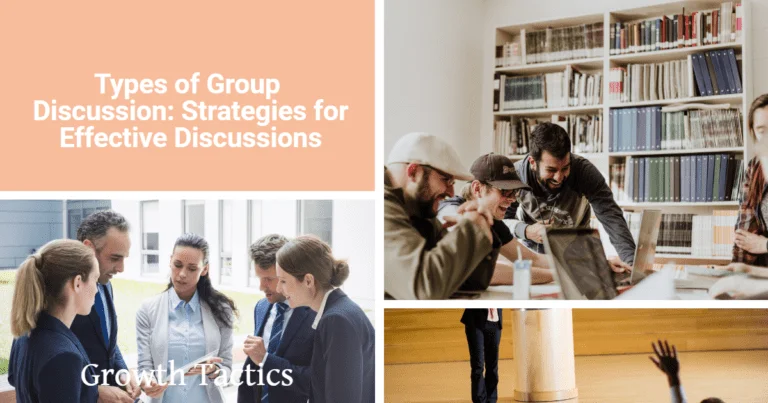Group discussion is a valuable tool for learning, collaboration, and fostering critical thinking skills. Whether you are a student preparing for an exam, an educator looking for ways to engage your students, or a leader trying to solve a problem, understanding the different types of group discussions, topics, and strategies is essential. In this blog post, we will explore the various types of group discussions, how to choose a suitable topic, and strategies for facilitating meaningful and productive discussions.
Jump To Section
Understanding Group Discussion
Group discussions are a form of interactive communication that involves a small group of individuals sharing their thoughts, ideas, and opinions on a specific topic. These discussions can take place in various settings, such as classrooms, organizations, or professional settings, and can serve different purposes, such as problem-solving, decision-making, or brainstorming.

Types of Group Discussion
Group discussions offer a dynamic environment for sharing thoughts, ideas, and opinions. They can be beneficial for learning, collaboration, and developing critical thinking skills. Let’s explore three types of group discussions: case-based discussions, topic-based discussions, and structured group discussions.
1. Case-Based Discussions
In case-based discussions, participants analyze and discuss specific cases or scenarios. They evaluate possible solutions or approaches, which helps develop problem-solving and analytical skills. By actively engaging with real or hypothetical case studies, participants enhance their ability to think critically about complex situations.
2. Topic-Based Discussions
Topic-based discussions center around a specific subject or theme. Participants express their opinions, present arguments, and explore different viewpoints. These discussions improve communication skills and foster critical thinking as participants analyze and evaluate various perspectives on a given topic.
3. Structured Group Discussions
Structured group discussions follow predefined formats or rules. A moderator guides the discussion by posing questions and facilitating conversation. This format ensures active participation and constructive exchanges, providing a framework for focused and productive discussions.
By understanding the different types of group discussions, participants can choose the most suitable format for their goals and create an engaging and interactive environment for meaningful conversations.
Choosing a Suitable Topic
Selecting an appropriate topic is crucial for a successful group discussion. Consider the following factors when choosing a topic:
1. Relevance to the Participants
The topic should be relevant to the participants’ interests, experiences, or areas of study. This helps create a sense of engagement and encourages active participation.
2. Controversial and Thought-Provoking
Controversial topics or those that require critical thinking and analysis can spark lively and meaningful discussions. Avoid vague or overly simplistic topics that do not stimulate thoughtful discussion.
3. Current Affairs and Real-World Issues
Discussing current affairs and real-world issues helps participants develop an understanding of the socio-economic and political landscape. These topics encourage participants to think critically and evaluate different perspectives.

Strategies for Effective Group Discussions
To make group discussions productive and engaging, consider implementing the following strategies:
1. Establish Clear Ground Rules
Start by establishing clear guidelines and expectations for the discussion. These ground rules should emphasize the importance of active listening, respectful communication, and equal participation. By setting a foundation of mutual respect and inclusivity, you create a safe and open environment for all participants to contribute their ideas.
2. Encourage the Expression of Diverse Perspectives
Promote a culture that values and encourages diverse perspectives. Encourage participants to share their unique viewpoints, experiences, and ideas. By actively seeking and embracing different perspectives, you enrich the conversation and foster a deeper understanding of the topic at hand. Remember that diversity of thought leads to more innovative and creative solutions.
3. Foster Lateral Thinking and Problem-Solving
Encourage participants to think critically and approach problems from various angles. Foster an environment that values and promotes lateral thinking, which involves exploring unconventional or alternative solutions. Encourage participants to challenge assumptions and consider different perspectives to generate innovative ideas and solutions.
4. Provide Structured Discussion Prompts
Prepare a list of discussion prompts or questions in advance to guide the conversation. These prompts should cover various aspects of the topic and encourage participants to think critically and express their thoughts. Structured discussion prompts provide a framework and keep the conversation focused and productive. This helps ensure that all important aspects of the topic are explored.
5. Facilitate Active Participation
Actively engage all participants to facilitate their active participation in the discussion. Encourage quieter participants to contribute by directly asking for their input or by creating a supportive environment that encourages them to share their thoughts. By ensuring that everyone feels heard and valued, you create a space for meaningful and collaborative discussions.
By implementing these strategies, you can make your group discussions more effective, inclusive, and thought-provoking. These approaches promote critical thinking, enhance problem-solving skills, and allow for the exploration of multiple perspectives. Remember that an open and respectful environment is key to fostering successful group discussions.
Common Challenges in Group Discussions and How to Overcome Them
Group discussions can be an effective way to generate ideas, facilitate collaboration, and arrive at well-informed decisions. However, there are common challenges that can arise during group discussions. Here are some of these challenges and strategies to overcome them:
1. Dominant Personalities
Some participants may have dominant personalities that can overpower the conversation, making others feel unheard or overshadowed. To prevent dominance, set equal speaking opportunities for everyone. Encourage active listening to make sure everyone’s voice is heard. If someone is dominating the conversation, try direct questions to other participants and redirecting the conversation towards the quieter members.
2. Groupthink
Groupthink occurs when the desire for group harmony leads to conformity and a lack of critical thinking. To avoid it, make sure to encourage diverse opinions, ideas, and perspectives. Assign a designated devil’s advocate whose role is to challenge proposed ideas. Anonymous ideation sessions and setting the tone of every idea is welcome helps in the same.
3. Lack of Focus
Conversations may easily veer off-topic or lack a clear focus, making it difficult to achieve the intended goals. Keep the conversation focused by setting and reviewing an agenda periodically. Encourage participants to take constructive breaks that revitalize their focus. Use summarizing techniques throughout the discussion to align the focus.
4. Unequal Participation
In some situations, certain individuals may dominate conversations while others stay silent. Encourage participation by assigning specific roles, and asking directly for input from quieter participants. Brainstorming techniques can be used like round-robin, think-pair-share, or small groups to ensure equal participation.
5. Conflict Resolution
Conflicts or disagreements may arise during group discussions, leading to stress and uncertainty. To handle conflicts constructively, encourage active listening, acknowledging different perspectives and viewpoints, facilitating open dialogue, and seeking win-win solutions. By creating an open and inclusive space to resolve conflicts, the group’s dynamics and outcomes will enhance positively.
By proactively addressing these common challenges, groups can have meaningful conversations that lead to actionable insights and productive solutions.

Technology and Group Discussions
Technology has revolutionized the way we communicate and collaborate in group settings. With the rise of virtual meetings, video conferencing, and online collaboration tools, it’s now easier than ever to conduct group discussions from anywhere in the world. However, with these benefits come new challenges as well. Here are some ways technology can impact group discussions and how to overcome them.
Pros of Using Technology in Group Discussions
Increased Flexibility and Accessibility: With online tools, group members can join meetings from anywhere, at any time. This allows for greater flexibility and accessibility, making it easier for people to participate in group discussions even if they are not physically present.
Improved Collaboration: Virtual tools allow group members to collaborate in real-time, regardless of their physical location. This makes it easier for members to share ideas and information, and work together to achieve a common goal.
Reduced Costs: Virtual meetings can significantly reduce costs associated with travel and facility rental. This makes it easier for groups with limited resources to conduct discussions without sacrificing the benefits of in-person meetings.
Cons of Using Technology in Group Discussions
Technical Difficulties: Technical difficulties can arise during virtual meetings, which can delay progress and cause frustration. This can be overcome by having all participants test the technology before the meeting and ensuring all participants have a stable internet connection.
Lack of Non-Verbal Cues: During virtual meetings, non-verbal cues such as body language and facial expressions can be difficult to read. To overcome this, group members must be clear and concise with their verbal communication.
Distractions: Since virtual meetings can be conducted from anywhere, it’s easy for participants to become distracted by their surroundings. To overcome this, establish ground rules for participants such as turning off notifications or finding a quiet space to participate in the discussion.
In conclusion, technology has revolutionized the way we conduct group discussions and collaboration. By being aware of the pros and cons of using virtual meetings and online collaboration tools, groups can take advantage of the benefits while mitigating the challenges.
Conclusion
Group discussions are an effective way to promote critical thinking, collaboration, and communication skills. By understanding the different types of group discussions, selecting suitable topics, and implementing effective strategies, educators and students can foster engaging and productive discussions. Remember to establish ground rules, encourage diverse perspectives, and provide structured prompts to make the most out of your group discussions.
Key Takeaways
- Group discussions can take various forms, including case-based and topic-based discussions.
- Choosing a relevant and thought-provoking topic is crucial for effective discussions.
- Strategies such as establishing ground rules and encouraging diverse perspectives enhance the quality of group discussions.
- Active participation and structured discussion prompts facilitate meaningful conversations.


